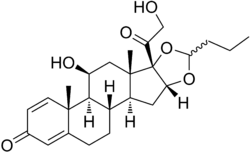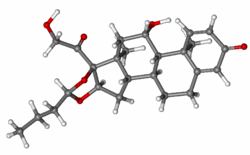Budesonide
 | |
 | |
| Clinical data | |
|---|---|
| Trade names | Pulmicort, Rhinocort, others |
| AHFS/Drugs.com | Monograph |
| MedlinePlus | a608007 |
| Pregnancy category |
|
| Routes of administration | By mouth, nasal, tracheal, rectal |
| ATC code | A07EA06 (WHO) D07AC09 (WHO), R01AD05 (WHO), R03BA02 (WHO) |
| Legal status | |
| Legal status |
|
| Pharmacokinetic data | |
| Bioavailability | 10-20% (first pass effect) |
| Protein binding | 85-90% |
| Metabolism | Hepatic CYP3A4 |
| Biological half-life | 2.0-3.6 hours |
| Excretion | Renal, faecal |
| Identifiers | |
| |
| CAS Number |
51333-22-3 |
| PubChem (CID) | 40000 |
| DrugBank |
DB01222 |
| ChemSpider |
4444479 |
| UNII |
Q3OKS62Q6X |
| KEGG |
D00246 |
| ChEMBL |
CHEMBL1370 |
| ECHA InfoCard | 100.051.927 |
| Chemical and physical data | |
| Formula | C25H34O6 |
| Molar mass | 430.534 g/mol |
| 3D model (Jmol) | Interactive image |
| |
| |
| | |
Budesonide (BUD), sold under the brand name Pulmicort among others, is a medication of the corticosteroid type.[1] It is available as an inhaler, pill, nasal spray, and rectal forms.[1][2] The inhaled form is used in the long-term management of asthma and chronic obstructive pulmonary disease (COPD).[1][3][4] The nasal spray is used for allergic rhinitis and nasal polyps.[2][5] The pills in a delayed release form and rectal forms may be used for inflammatory bowel disease including Crohn's disease, ulcerative colitis and microscopic colitis.[6][7]
Common side effects with the inhaled form include respiratory infections, cough, and headaches. Common side effects with the pills include feeling tired, vomiting, and joint pains. Serious side effects include an increased risk of infection, loss of bone strength, and cataracts. Long-term use of the pill form may cause adrenal insufficiency. Stopping the pills suddenly following long-term use may therefore be dangerous. The inhaled form is generally safe in pregnancy. Budesonide is mainly a glucocorticoid.[1]
Budesonide was initially patented in 1973.[8] Commercial use as an asthma medication began in 1981.[9] It is on the World Health Organization's List of Essential Medicines, the most important medication needed in a basic health system.[10] Some forms are available as a generic medication.[11] The wholesale price in the developing world for an inhaler containing 200 doses is about 5 to 7 USD as of 2014.[12] As of 2015 the cost for a typical month of medication in the United States is 100 to 200 USD.[11]
Medical uses
Asthma
Budesonide is nebulized for maintenance and prophylactic treatment of asthma including patients who require oral corticosteroids and those who may benefit from a systemic dose reduction.[13]
Inflammatory bowel disease
Formulations of delayed-release Budesonide can be effective treatment for mild-to-moderately active Crohn's disease involving the ileum and/or ascending colon.[14] A Cochrane review found evidence for up to 3 months (but not longer) of maintenance of remission Crohn's disease.[15]
Budesonide assists in the induction of remission in people with active ulcerative colitis.[16]
Allergic rhinitis
Nasal spray budesonide is a treatment for allergic rhinitis.[17]
Side-effects
Budesonide may cause:[18]
- Nose irritation or burning
- Bleeding or sores in the nose
- Lightheadedness
- Upset stomach
- Cough
- Hoarseness
- Dry mouth
- Rash
- Sore throat
- Bad taste in mouth
- Change in mucus
In addition, the following symptoms should be reported immediately:
- Difficulty breathing or swelling of the face
- White patches in the throat, mouth, or nose
- Irregular menstrual periods
- Severe acne
- On rare occasions, behavioral changes (mostly affecting children)[18]
Contraindications
Budesonide is contraindicated as a primary treatment of status asthmaticus or other acute episode of asthma where intensive measures are required.[19] It is also contraindicated for patients who have hypersensitivity to budesonide.[20]
Mechanism of action
Budesonide:
- Controls the rate of protein synthesis.
- Depresses the migration of polymorphonuclear leukocytes and fibroblasts.
- Reverses capillary permeability and lysosomal stabilization at the cellular level to prevent or control inflammation.
- Has a potent glucocorticoid activity and weak mineralocorticoid activity.
Dietary considerations
Those taking tablets or capsules orally should avoid grapefruit juice and echinacea.
- Grapefruit juice may double bioavailability of oral budesonide.
- Echinacea diminishes bioavailability.
Also, high fat meals delay absorption but do not impede absorption.
Pharmacokinetics
- Onset of action: Nebulization: 2–8 days; Inhalation: 24 hours
- Peak effect: Nebulization: 4–6 weeks; Inhalation: 1–2 weeks
- Distribution: 2.2-3.9 L/kg
- Protein binding: 85% to 90%
- Metabolism: Hepatic via CYP3A4 to two metabolites: 16 alpha-hydroxyprednisolone and 6 beta-hydroxybudesonide; minor activity
- Bioavailability: Limited by high first-pass effect; Capsule: 9% to 21%; Nebulization: 6%; Inhalation: 6% to 13%
- Half-life elimination: 2-3.6 hours
- Time to peak: Capsule: 0.5–10 hours (variable in Crohn's disease); Nebulization: 10–30 minutes; Inhalation: 1–2 hours; Tablet: 7.4-19.2 hours
- Excretion: Urine (60%) and feces as metabolites.
Brand names
Aeronide (TH); Aquacort (DE); B Cort (CO); Bronex (PH); Budair (MY); Budecort DP (MY); Budenofalk (DE, GB, HK, KP, PH, SG); Budeson (AR); Budeson Aqua (AR); BudeSpray (TH); Budiair (KP); Budicort Respules (IL); Bunase (TH); Clebudan (CN); Cycortide (HK); Denecort (PH); Duasma (TW); Eltair (MY); Entocort (AR, AT, BE, BR, CH, CZ, DK, FI, FR, GB, HK, IE, IL, IT, KP, NL, NO, PL, PT, SE, TR); Giona Easyhaler (MY, SG, TH); Inflammide (PE); Miflonid (CZ); Miflonide (BE, DE, IL, IT, NZ, PT); Neumocort (PY); Novopulmon (DE, FR); Pulmicon Susp for Nebulizer (KP); Pulmicort (AT, BE, BG, BR, CH, CL, CN, CO, CR, CZ, DE, DK, DO, EE, FI, FR, GB, GR, GT, HN, ID, IN, NI, NL, NO, PA, PK, PL, PT, RU, SE, SV, TR, TW, UY, VE, ZA); Pulmicort Nasal Turbohaler (CL, KE, MU, NG); Pulmicort Turbuhaler (KE, MU, NG); Rafton (FR); Rhinocort (AU); Rhinocort Aqua (HK); Rhinoside (GR); Symbicort (FR, US, ZA) Uceris (US)
See also
References
- 1 2 3 4 "Budesonide". The American Society of Health-System Pharmacists. Retrieved Dec 2, 2015.
- 1 2 "Budesonide eent". The American Society of Health-System Pharmacists. Retrieved Dec 2, 2015.
- ↑ De Coster, DA; Jones, M (2014). "Tailoring of corticosteroids in COPD management.". Current respiratory care reports. 3: 121–132. doi:10.1007/s13665-014-0084-2. PMID 25089228.
- ↑ Christophi, GP; Rengarajan, A; Ciorba, MA (2016). "Rectal budesonide and mesalamine formulations in active ulcerative proctosigmoiditis: efficacy, tolerance, and treatment approach.". Clinical and experimental gastroenterology. 9: 125–30. PMID 27274301.
- ↑ Rudmik, L; Schlosser, RJ; Smith, TL; Soler, ZM (July 2012). "Impact of topical nasal steroid therapy on symptoms of nasal polyposis: a meta-analysis.". The Laryngoscope. 122 (7): 1431–7. doi:10.1002/lary.23259. PMID 22410935.
- ↑ Silverman J, Otley A (2011). "Budesonide in the treatment of inflammatory bowel disease.". Expert Rev Clin Immunol. 7 (4): 419–28. doi:10.1586/eci.11.34. PMID 21790284.
- ↑ Pardi DS, Tremaine WJ, Carrasco-Labra A (2016). "American Gastroenterological Association Institute Technical Review on the Medical Management of Microscopic Colitis". Gastroenterology. 150 (1): 247–274.e11. doi:10.1053/j.gastro.2015.11.006. PMID 26584602.
- ↑ Domeij, Bengt (2000). Pharmaceutical patents in Europe. The Hague: Kluwer Law International. p. 278. ISBN 9789041113481.
- ↑ Hamley, Peter (2015). Small Molecule Medicinal Chemistry: Strategies and Technologies. John Wiley & Sons. p. 390. ISBN 9781118771693.
- ↑ "WHO Model List of EssentialMedicines" (PDF). World Health Organization. October 2013. Retrieved 22 April 2014.
- 1 2 Hamilton, Richart (2015). Tarascon Pocket Pharmacopoeia 2015 Deluxe Lab-Coat Edition. Jones & Bartlett Learning. p. 451. ISBN 9781284057560.
- ↑ "Budesonide". International Drug Price Indicator Guide. Retrieved 5 December 2015.
- ↑ Global Strategy for Asthma Management and Prevention, Global Initiative for Asthma (GINA) 2011. Available at http://www.ginasthma.org
- ↑ Lichtenstein GR, Hanauer SB, Sandborn WJ (2009). "Management of Crohn's Disease in Adults". Am J Gastroenterol. 104 (2): 465–83. doi:10.1038/ajg.2008.168. PMID 19174807.
- ↑ Kuenzig ME, Rezaie A, Seow CH, Otley AR, Steinhart AH, Griffiths AM, et al. (2014). "Budesonide for maintenance of remission in Crohn's disease.". Cochrane Database Syst Rev. 8: CD002913. doi:10.1002/14651858.CD002913.pub3. PMID 25141071.
- ↑ Habal FM, Huang VW (2012). "Review Article: A Decision-Making Algorithm For the Management of Pregnancy in the Inflammatory Bowel Disease Patient". Aliment Pharmacol Ther. 35 (5): 501–15. doi:10.1111/j.1365-2036.2011.04967.x. PMID 22221203.
- ↑ Stanaland, BE (April 2004). "Once-daily budesonide aqueous nasal spray for allergic rhinitis: a review.". Clinical therapeutics. 26 (4): 473–92. doi:10.1016/s0149-2918(04)90050-1. PMID 15189745.
- 1 2 BUDESONIDE - NASAL AEROSOL INHALER (Rhinocort) side effects, medical uses, and drug interactions Archived November 6, 2008, at the Wayback Machine.
- ↑ Todd GR, Acerini CL, Buck JJ, Murphy NP, Ross-Russell R, Warner JT, McCance DR (2002). "Acute Adrenal Crisis in Asthmatics Treated With High-Dose Fluticasone Propionate". Eur Respir J. 19 (6): 1207–9. doi:10.1183/09031936.02.00274402. PMID 12108877.
- ↑ Todd GR, Acerini CL, Ross-Russell R, Zahra S, Warner JT, McCance D (2002). "Survey of Adrenal Crisis Associated With Inhaled Corticosteroids in the United Kingdom". Arch Dis Child. 87 (6): 457–61. doi:10.1136/adc.87.6.457. PMC 1755820
 . PMID 12456538.
. PMID 12456538.
External links
- Entocort EC Prescribing information Prometheus Laboratories (PDF)
- Budesonide Oral (Entocort EC) MedlinePlus, National Institutes of Health (NIH), U.S. National Library of Medicine
- Budesonide Nasal Spray (Rhinocort) MedlinePlus, National Institutes of Health (NIH), U.S. National Library of Medicine
- Budesonide Oral Inhalation (Symbicort) MedlinePlus, National Institutes of Health (NIH), U.S. National Library of Medicine